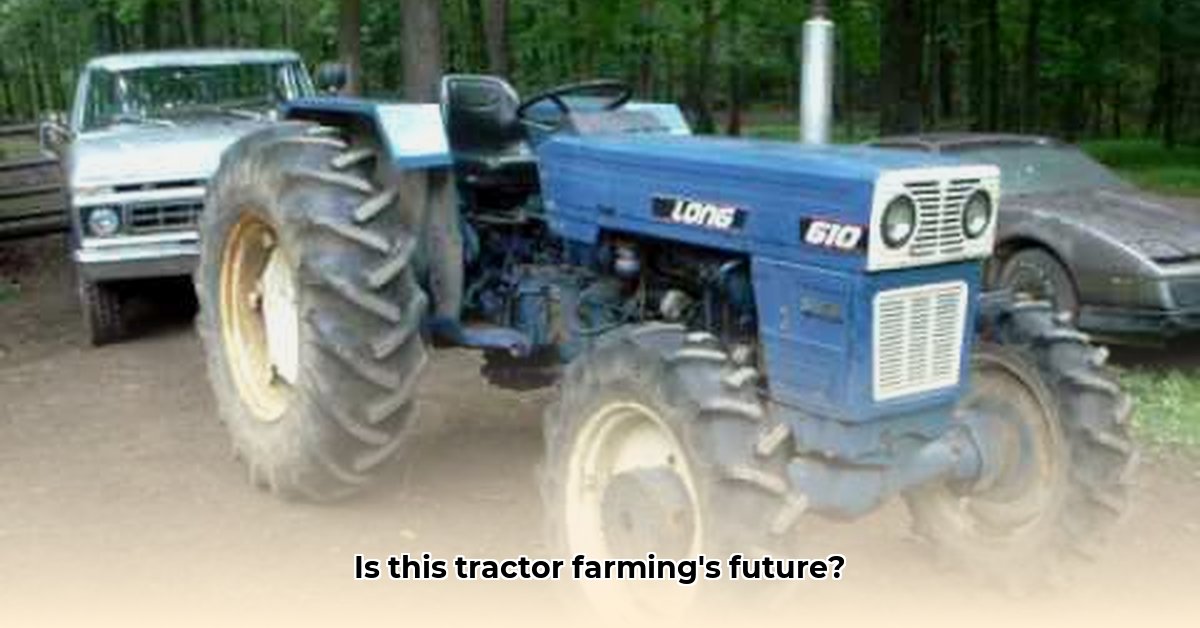
The Long 610 tractor, a product of the late 20th century, presents a compelling case study in the intersection of vintage agricultural technology and modern sustainability goals. This detailed technical review examines its capabilities and limitations within the context of sustainable farming practices. For more on tractor history, see this helpful resource: A Short History of Tractors.
Engine and Performance: Assessing the Power Output
The Long 610 was equipped with a 3.6-liter, four-cylinder diesel engine, generating approximately 64 PTO horsepower (power take-off) and approximately 56.12 drawbar horsepower. While this power output is modest compared to modern tractors, it was likely sufficient for many smaller farms and specific applications during its operational period. The lower horsepower may reflect a design philosophy prioritizing fuel efficiency over sheer power.
Fuel Efficiency: A Comparative Analysis
The Long 610's 54-liter fuel tank, small by today's standards, raises questions about its fuel efficiency. While anecdotal evidence suggests it was relatively thrifty, concrete data on fuel consumption per hour is needed for a robust comparison with modern tractors. This data gap hinders a definitive assessment of its sustainability.
Sustainability Metrics: Unanswered Questions
A full sustainability assessment requires more detailed data than currently available. Key missing information includes:
- Greenhouse gas emissions (GHGs): Quantifying the CO2 and other GHG emissions per hour of operation is essential for a complete environmental impact assessment.
- Fuel consumption rate: Precise measurements of fuel burn for various tasks are needed to accurately compare it with modern tractors.
- Lifecycle analysis (LCA): A comprehensive LCA encompassing manufacturing, operation, and disposal would provide a holistic view of the tractor's environmental footprint. This includes the environmental costs of procuring raw materials and handling waste generated during its lifespan.
Technology and Functionality: A Review of Design Features
The Long 610 features mechanical systems instead of the sophisticated electronics found in modern tractors. Its mechanical rear differential lock and spur gear final drives, while robust, lack the modern hydraulic system enhancements. The open operator station, while providing good visibility, lacks the safety and climate control features of contemporary designs. These design choices present a trade-off between simplicity, resilience, and operator well-being, which must be analyzed in any sustainability assessment.
Sustainability in Context: The Case for Small-Scale Farming
The Long 610's relatively lower power output aligns well with the needs of smaller farms that prioritize efficiency and reduced environmental impact. Its likely lower fuel consumption could represent significant cost savings and emissions reductions compared to larger, modern tractors. However, its lower productivity needs to be factored into the overall efficiency calculation. More work is needed to determine if potential fuel savings outweigh the increased labor costs.
Actionable Insights: A Multi-Stakeholder Approach
Achieving a comprehensive understanding of the Long 610's sustainability requires collaborative efforts:
| Stakeholder | Actionable Steps |
|---|---|
| Small-Scale Farmers | Evaluate parts availability; assess cost-effectiveness; consider restoration/efficiency upgrades. |
| Agricultural Historians | Document operational data and historical context. |
| Environmental Researchers | Conduct a comprehensive LCA; develop a comparative dataset for evaluating older vs. modern tractors. |
Data Gaps and Future Research: Addressing Critical Knowledge Gaps
Further research is crucial to fully understand the Long 610's role in sustainable agriculture. Key areas requiring investigation include:
- Detailed fuel consumption under various operating conditions.
- Maintenance costs throughout its operational lifespan.
- Comprehensive GHG emissions and environmental impact assessment.
- Soil compaction levels compared to modern tractors.
- Risk assessment of the spur gear final drives and open operator station.
Conclusion: Re-evaluating a Vintage Workhorse
The Long 610 tractor offers a valuable opportunity for research into the intersection of vintage technology and sustainable farming. Its suitability for modern sustainable agriculture isn't fully established. Rigorous data collection and analysis are essential to determine if it is a viable sustainable option, a niche tool for certain applications, or simply a relic of the past. Further research is needed to provide definitive answers.
How to Assess the Long-Term Environmental Impact of a Long 610 Tractor?
Assessing the Long 610's long-term environmental impact demands a holistic approach that considers its entire lifecycle, beyond simple fuel consumption:
- Fuel Consumption and Emissions: Measure fuel usage and calculate associated GHG emissions. Consider the environmental impact of the fuel type.
- Maintenance and Repair: Document repair frequency and the resource consumption (material, energy) for manufacturing and transporting replacement parts.
- Parts Sourcing Strategies: Evaluate the environmental impact of sourcing new versus used or refurbished parts. Prioritizing sustainable sourcing practices significantly lessens the environmental impact.
- End-of-Life Management: Develop a plan for responsible disposal or recycling to minimize potential environmental pollution.
A comparative analysis of the Long 610 with modern tractors is vital. While modern machinery boasts improved fuel efficiency and emission controls, the initial manufacturing process and the technology's complexity contribute significantly to their environmental footprint. The Long 610's potential longevity, if properly maintained, might offset some of the inherent environmental costs of manufacturing modern tractors. Ultimately, responsible ownership practices can significantly influence the overall sustainability of utilizing a Long 610 tractor.